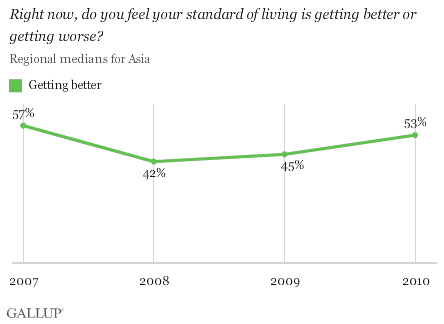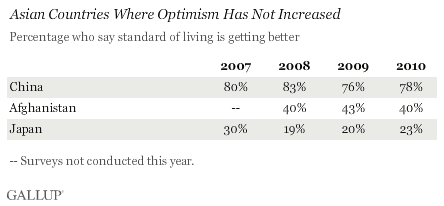WASHINGTON, D.C. -- Reflecting Asia's resilience after the global economic crisis, Gallup surveys in 2010 show people's optimism about their financial well-being is rebounding across the region. A median of 53% of residents in 19 countries now say their standard of living is getting better, nearing the pre-crisis median of 57% in 2007.

The speed and strength of Asia's rebound from the global crisis are two factors that enabled the Asian Development Bank (ADB) to conclude last week that recovery seemed to have taken a firm hold and to raise its economic growth forecast for the region. Strong export recovery, robust private demand, and sustained effects of stimulus policies that ADB says helped the region grow in the first half of 2010 may help explain why people's optimism has already recovered to pre-crisis levels in 10 Asian countries.

Residents' optimism about their financial well-being sank to great depths in developed economies such as Singapore and Australia during the crisis, which makes their almost meteoric recovery more remarkable. In Singapore, where ADB now forecasts double-digit growth in 2010, residents are even more likely to say their living standards are getting better this year than they were before the crisis.
But a return to pre-crisis levels or improvement beyond those levels doesn't mean majorities in all countries see their living standards as getting better; less than half of Mongolians, Cambodians, and Indonesians do so. Improvements, however, can still be interpreted as a positive indicator.
Financial Well-Being Still in Recovery in Several Large Economies
In six countries, including some of world's larger economies, optimism hasn't fully recovered to pre-crisis levels, but it is recovering. In India, for example, where ADB has slightly upgraded its growth forecast, residents are more likely to see their standard of living improving this year than they were last year. They are still less likely than they were before the global economic crisis to say their standard of living is getting better.

It's important to note that Gallup conducted surveys in Pakistan before the devastating floods there, and the 40% of Pakistanis who saw their standard of living as getting better at the time has likely changed.
Little Change in China, Japan, and Afghanistan
Residents in China, Japan, and Afghanistan are among the few in the region who aren't more optimistic now than they were before the global crisis -- but each country's story is different. Chinese are already the most optimistic in the region about their financial well-being -- the 78% who say their standard of living is getting better is essentially unchanged from the 80% who said the same before the economic crisis hit.

Japan, on the other hand, entered recession in the third quarter of 2008, and Japanese consumers' somewhat dour outlooks on their standard of living have failed to improve since. Afghans' optimism has also stagnated during the same period, likely reflecting ongoing volatility there in the security situation and governance.
Implications
Gallup's data for the most part reaffirm the International Monetary Fund's assessment that "Asia is emerging from the recession with its standing in the world strengthened." Rebounding optimism in many Asian countries reflects the region's robust recovery from the global economic crisis and positions it well for sustainable, consumer-led growth going forward. That optimism has not fully rebounded in large economies such as South Korea, India, and Japan is a reminder that the outlook for global recovery still remains somewhat murky.
For complete data sets or custom research from the more than 150 countries Gallup continually surveys, please contact SocialandEconomicAnalysis@gallup.com or call 202.715.3030.
Survey Methods
Results are based on face-to-face and telephone interviews with approximately 1,000 adults in each country for each year reported in this article, with the exception of the India sample, which was higher (2,000 to 6,000 interviews). For results based on each sample of national adults, one can say with 95% confidence that the maximum margin of sampling error ranged from a low of ±1.7 percentage points to a high of ±4.5 percentage points.
